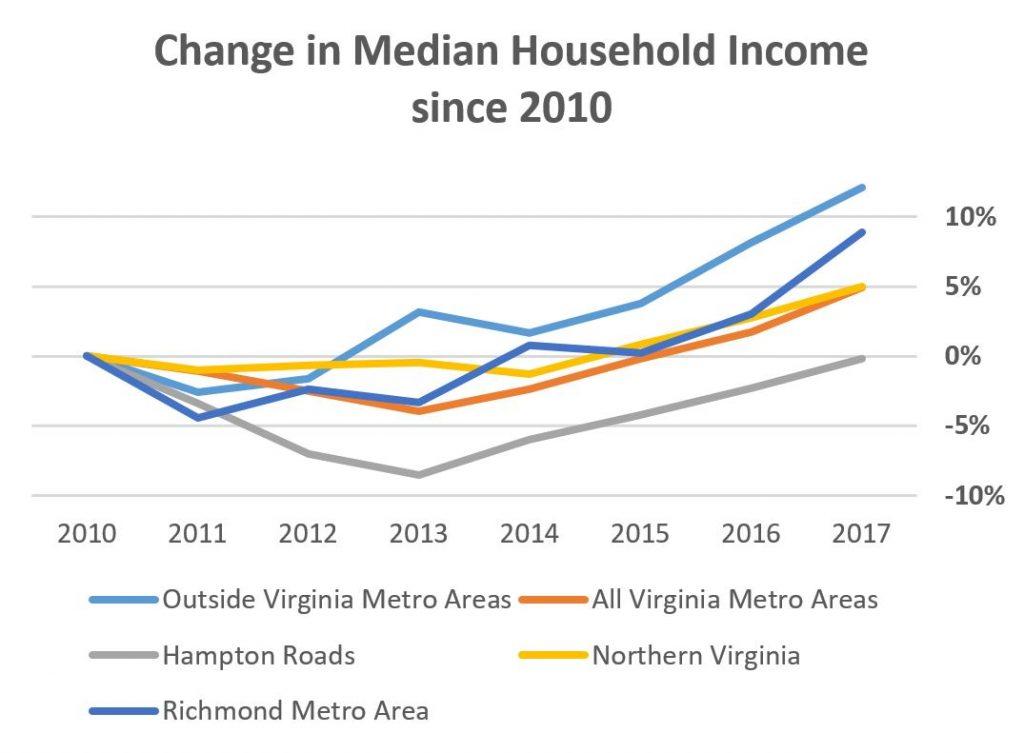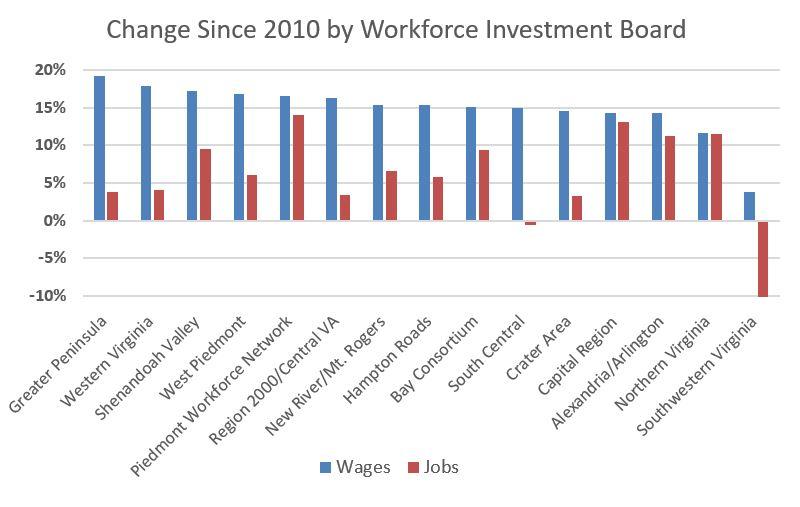Since 2010, household incomes have risen the most in rural Virginia
Economic divergence between America’s urban and rural areas has been one of the most frequently discussed trends during the past decade. Dimensions of this divergence include growth (or loss) in population, jobs, and household income. Population estimates released by the Weldon Cooper Center earlier this year showed that 94 percent of growth in Virginia since 2010 was concentrated in its three largest metro areas: Hampton Roads, Northern Virginia and Richmond, while the population living outside metro areas declined by 3 percent during the period. Similarly, Census data shows that the number of jobs in Virginia’s metro areas has risen by 6 percent since 2011, while in non-metro areas, the number of jobs declined by 7 percent.
Though both population and jobs data confirm a divergence between the economies of urban and rural Virginia, the data does not indicate a growing socioeconomic gap. Household income data provides a better picture of Virginians’ material well-being and, according to Census data, shows an opposite trend. While the median household income in Virginia’s non-metro areas is lower than in metro areas, it has risen by 12 percent since 2010, compared to just 5 percent in Virginia’s metro areas. Similarly, poverty rates outside Virginia’s metro areas have fallen more than in Virginia’s metro areas since 2010 and are now lower than before the recession.

Determining which Virginia regions have seen the largest rises in income this decade is difficult. The main source for household income data is the Census Bureau’s American Community Survey which combines data for localities with less than 100,000 residents into five year surveys to maintain data accuracy. As a result, for the large majority of Virginia localities, the most recent income data is from the 2013-2017 American Community Survey which includes data that is now over six years old. Fortunately, in 2012, the Census Bureau combined smaller localities into larger geographies called Public Use Microdata Areas (see the map below), so annual income data would be available for every part of Virginia.
Change in Median Household Income 2012 to 2017
Since 2012, household income in portions of Southside and Southwest Virginia rose by 16 percent, double the statewide rate of 8 percent. Though less than 30 percent of Virginia’s population lives outside its three largest metro areas, 10 of the 20 Census Microdata Areas with income growth above Virginia’s rate were located outside its three largest metro areas. Income growth in the cities of Alexandria, Lynchburg and Richmond, which have experienced a surge in development in recent years, also exceeded statewide income growth since 2012.
Wage data for Virginia’s workforce investment board regions shows a similar trend, with the largest increases in earnings this decade concentrated in western Virginia and Southside, while earnings have increased the least in Northern Virginia and Richmond. Earnings have risen more quickly for workers across nearly every industry outside Virginia’s three largest metro areas. Health care workers, construction workers, janitors and cleaners, as well as those working in real estate and property maintenance saw some of the largest wage increases this decade.

Virginia’s wage and employment data this decade highlight two somewhat confounding trends. Wages have grown the most outside Virginia’s largest metro areas, yet job growth there has been mostly weak or non-existent. While the number of jobs has increased far more quickly in Hampton Roads, Northern Virginia and Richmond, wage growth in the metro areas has been slower. There are a couple possible reasons for the opposing trends. Despite slower growth rates, absolute wages in Virginia’s largest metro areas typically pay more than in the rest of Virginia and continue to attract workers. Meanwhile, in the more rural areas of Virginia, the population is aging, often shrinking the labor force but also forcing employers to raise wages to attract or keep employees.
In some ways, this decade’s trend of faster wage growth in more rural parts of Virginia, but faster job growth in more urban areas of Virginia is a continuation of an older trend that was common over the last century. In much of the 20th century, workers moved from low income counties to high income counties in large numbers across Virginia and the nation. Workers moving to high income and more urban counties increased the urban labor supply, keeping wages down, while workers leaving low income and more rural counties shrunk the rural labor supply, forcing employers to increase productivity and wages. Fairfax County is a good example of this trend in Virginia. In 1970, Fairfax County had the highest average family income among Virginia’s counties. Today, Fairfax County still has the second highest average family income, but despite adding more residents than any other Virginia county over the last 50 years, Fairfax County’s average family income has grown more slowly during the period than the majority of Virginia counties, many of them rural.
Average Family Income by County, 1970 and 2017
Today, an aging population–rather than residents moving away–is tightening the labor supply in many of Virginia’s rural counties and pushing wages up. Over the next couple of decades, employers in many rural counties will likely be forced to raise wages more and invest in automation to combat a projected decline in the workforce. If current trends continue, the income gap between rural and urban Virginia should close further.
Yet the economies of rural and urban Virginia appear to be heading in different directions. Shrinking working age populations in the coming decades will likely make it more difficult for rural counties to attract new employers who prefer a stable labor force. At the same time, the workforce of Virginia’s larger metro areas will continue to grow. Today’s higher college attendance rates also favor large metro areas since new graduates are more likely to move to a larger labor market to find a job in their profession. While the socioeconomic differences between rural and urban Virginia may continue to dissolve, population and job growth will likely continue to shift Virginia’s economic and political center eastward and northward towards its largest metro areas.


